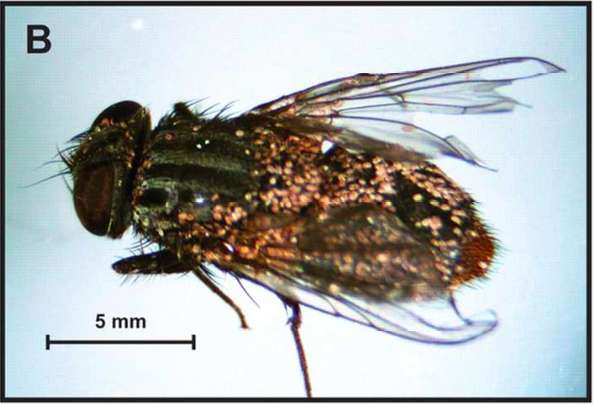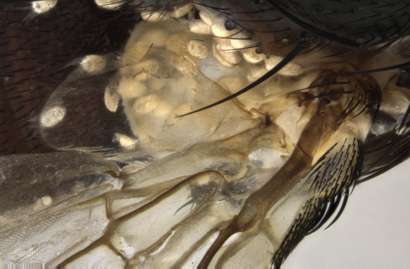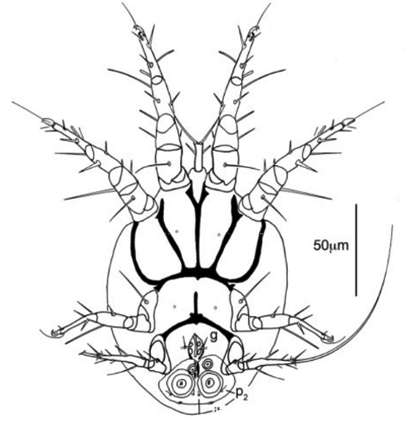Carrion feeding Myianoetus muscarum mites is hitching a ride to their next meal on the fly Synthesiomyia nudiseta. Credit: Entomological Society of America
In 1879, long before TV shows like CSI and Bones created a generation of armchair forensic entomologists, Jean Pierre Mégnin, one of the first scientists to use insect evidence to aid death investigations, examined the desiccated body of a female infant found in a vacant lot in Paris.
"The mummy of the child in question is covered in a layer of fine brown powder that is exclusively composed of the [casings/shed layers] of the mites and their feces … I did not find any living mites on the surface of the body, but inside the skull there was still a large, writhing, active colony … All of these mites being to a single species, Tyroglyphus longer … The colonies of mites and the maggots found on the cadaver prove that the time of death of the mummy is approximately between six and eight months."
– Translated from the French by Dr. Rebecca Symula and Dr. Rebecca McCaffery
This excerpt, from his account of the case that was published in one of the earliest forensic entomology texts, La Faune des Cadavres: Application De L'Entomologie a la Medecine Légale (1894), describes what was perhaps the first use of mites to help determine the age of a corpse, and also one of the last until now.
Between Mégnin's cases in nineteenth-century Paris and today, only a few forensic investigations have used evidence from the mites found on bodies to estimate time of death. However, the authors of a recent paper published in the Journal of Medical Entomology hope to change that. Dr. Meaghan Pimsler and co-authors describe three forensic investigations in which the mite Myianoetus muscarum was found on corpses in association with a fly that is commonly used by forensic entomologists to estimate time of death. Pimsler and colleagues believe that a better understanding of the succession of mite communities on cadavers could lead to more accurate estimations of the postmortem interval.
The mite Myianoetus muscarum feeds on vertebrate carrion, including human remains. While carrion is very nutritious, it is an ephemeral resource that appears randomly in the environment. Finding a carcass and getting yourself to this banquet is not easy when you're a flightless, crawling mite less than one millimeter in length. That's where the fly Synthesiomyia nudiseta comes in.
A close-up photo of Myianoetus muscarum deutonymphs attached near the calypters of a Synthesiomyia nudiseta fly.
Flies are highly mobile and excel at finding dead things. So at one stage in its life cycle, the deutonymphal instar, the mite M. muscarum devotes itself to a single purpose: finding and attaching itself to an outbound fly. It's like having a private plane to fly you to the hottest restaurant in the country on a moment's notice.
This relationship, between mite and fly, is called "phoresy." Phoresy is when one species attaches itself to another solely for the purpose of transportation. A dog might transport a tick from one place to another, but that is not phoresy because the tick feeds on the dog while getting a ride. But M. muscarum does not feed on the fly S. nudiseta. It's just using the fly to get to its next meal. Phoresy is a common strategy for tiny invertebrates that feed on patchy, fleeting resources like carrion, dung, or mushrooms. For instance, some phoretic mites that feed on vertebrate feces will hitch a ride on dung beetles to get to the next fresh pile of poop.
In this paper, Pimsler and her colleagues document the first known phoretic association between a mite and S. nudiseta in the continental U.S. More importantly, they hope that their work will help spur researchers to pay more attention to mites and their role in decomposition. Pimsler says most forensic entomology investigations generally focus on larger insects such as flies, beetles, or sometimes less well-known carrion eaters like scorpionflies and noctuid caterpillars. Oftentimes, investigators may note that mites are present, but do not identify them to species or even genus.
A line drawing of the deutonymphal instar of Myianoetus muscarum.
But Pimsler and her co-authors believe that paying attention to mites could improve estimates of postmortem intervals. These estimates rely on a timeline of when different species typically arrive on a corpse and how long they take to develop. Mites and their developmental stages would add more time points to this timeline, allowing for more precise estimates.
Mites may also affect the timelines and presence of other insects commonly used by forensic entomologists. They may compete with the insects for food (the corpse), thus slowing their development, or in some cases may even feed on the insects. Some mites suck "maggot hemolymph like tiny vampires," according to Pimsler.
"The truth is that we really do not know, right now, all of the utility mites may have in forensic investigations," Pimsler said.
But perhaps someday the critical clue in a murder case will not be the fly itself, but rather the tiny, eight-legged scavenger that hitched a ride on the fly to get to the body.
More information: Journal of Medical Entomology, jme.oxfordjournals.org/lookup/ … i/10.1093/jme/tjv203
Journal information: Journal of Medical Entomology
Provided by Entomological Society of America


























